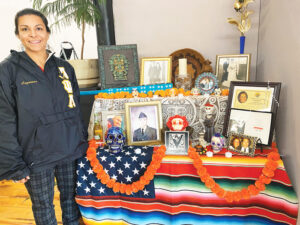
Por Claudia Annoni, La Prensa
El Día de los Muertos se celebra en muchos países de América Latina. Cada uno le da un toque personal, pero en todos conserva el mismo significado.
Esta celebración data de la época de las antiguas culturas indígenas de los Aztecas, Maya, Purepechas, Nahuas y Totonacas que dedicaron rituales a sus ancestros.
Esta es una ocasión donde los familiares se acercan espiritualmente a los seres queridos que han fallecido y dan honor a la vida. Es una verdadera celebración, llena de colores y recuerdos, y se ve la muerte desde otra perspectiva.
En México, la tradición llama a adorna las tumbas. Usando principalmente una flor naranja llamada cempazuchitl. En las casas se hace un altar en honor a los parientes difuntos. Se colocan alimentos y bebidas para que el difunto en la noche venga a recordar esos gustos de su vida y fotos de ellos.
En otros países como Guatemala y Perú se utilizan flores y se dan ofrendas. Venezuela y Argentina toman esta fecha para rendir honor a sus muertos y llevarles flores al cementerio.
En Ecuador es un verdadero encuentro de las familias donde se reúnen a comer y beben la colada morada, una bebida hecha a base de maíz violeta, de moras y de otras frutas.
Honduras, Costa Rica y Colombia considera este día una fiesta religiosa, se asiste al cementerio para llevar recordatorios pero también se concurre a la Iglesia para rezar por los difuntos y pedir por la salud y felicidad de los vivos.
Day of the Dead: Celebration throughout Latin America
By Claudia Annoni, La Prensa
Day of the Dead is celebrated in several countries of Latin America. Each one gives a personal touch, but the meaning remains the same.
This celebration began in the ancient indigenous cultures such as the Aztecs, Maya, Purepechas, Nahuas, and Totonacas, who dedicated ritual to their ancestors.
This is an occasion to become spiritually close to the love ones who died and to honor their lives. It is a celebration, full of colors and remembrance. Death is seen from a different perspective as often viewed in Europe.
In México, the tradition is to decorate the graves. Mainly using an orange flower called cempazuchitl. In the houses, altars are displayed to honor the family members who died. Placing food and drinks so the love ones can come back and remember what they enjoyed when they were alive; and also their pictures. The local cemeteries become alive with music, flowers, food, and families.
In Guatemala and Perú, flowers are used as offerings. Venezuela and Argentina use this day to honor their dead and bring them flowers to the cemetery.
In Ecuador, it turns into a true family gathering; they eat and drink a purple beverage made of purple corn, blackberries, and other fruits.
Honduras, Costa Rica, and Colombia consider this day as a religious celebration. People will go to the cemetery and bring offerings but also go to church to pray for the love ones who died and ask for health and happiness for the ones alive.

